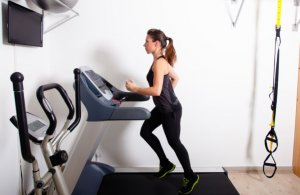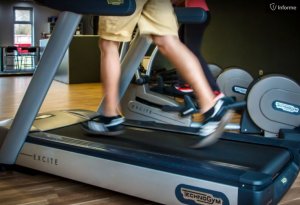5 Ways to Improve Treadmill Workouts

Although we can make changes in slope, intensity, and type of movement, treadmills may seem monotonous. However, they do fulfill their objective perfectly: to burn calories and improve our strength. Therefore, although it may seem a static exercise, its use is very positive.
Vary the slope
We may forget that this machine only consists of a ribbon, located in a straight position, where only the speed is graduated. What you may not know is that you can also modify the slope of the terrain, as if you were walking uphill. This change will bring considerable variation to our routines.

The first advantage of the treadmill is that we don’t have to strain the joints as much to burn the same amount of calories. Resistance allows us to make a greater effort with less movement. In this case, we can also strengthen the legs and glutes.
It’s useful to remember that these aforementioned muscles benefit from the steepness of the slope. Another advantage is that there is less impact on the knees and back. The lack of impact is very beneficial for people of a certain age.
Exercises typically of the running technique
If it’s a question of legs, the running technique offers us a few variables of exercises.
For example, with a very low speed, we can walk straight on tiptoes or with heels. Short jumps are another one of the options that we can use on the treadmill.
We could also imitate the main running position in athletics, or try the marathon walk. The best thing about this is that we will add some difficulty.
Vary the speed of the treadmill
Going faster is not always synonymous with burning more calories. In fact, if we wear ourselves out faster, there is a chance that at some point, we will give up. Perhaps it’s much better to alternate speeds than to exhaust ourselves through greater intensity.
In this way, we can vary speeds and create stages to impose challenges for each intensity. We must remember that the time spent on treadmills usually ranges from between 20 and 60 minutes, depending on the individual and the objective. This time can be divided into different stages of speed.

For example, 10 minutes can be allocated to a slower speed. Then, we can do six to eight races at a rapid pace within one minute. Every time we reach the one minute mark, we can slow down to take a breath.
Finally and at the end of the exercise, we can lower the speed and climb an incline. To finish, jog for five minutes and end the session feeling more relaxed.
Complete the training with other types of exercises
This idea is perfect for working the muscles and volume of the legs and glutes. It’s feasible to keep using the machine for your main training and complement it with other exercises. Squats are an excellent addition.
Another point is that you can also specifically work on the calves. After a session on the treadmill, do toe raises. It’s also good to combine cardio with a demanding abdominal workout.
We must remember that, when we run, we basically work on our resistance and burn calories. Exercising the abdominal area also benefits from this dynamic. So we’ll only reinforce the intention of this type of body conditioning.
Treadmills: alternate with other similar machines
The treadmill isn’t the only gym machine designed to move the legs. There are also bicycles frequently used in spinning and stair steppers. If we alternate these tools we’ll make our training far more fun and dynamic.
In short, there is no reason to become bored with the treadmill. It’s necessary to alternate exercises, create routines and turn up the incline. There is no longer any excuse to stop dropping those extra pounds!
Although we can make changes in slope, intensity, and type of movement, treadmills may seem monotonous. However, they do fulfill their objective perfectly: to burn calories and improve our strength. Therefore, although it may seem a static exercise, its use is very positive.
Vary the slope
We may forget that this machine only consists of a ribbon, located in a straight position, where only the speed is graduated. What you may not know is that you can also modify the slope of the terrain, as if you were walking uphill. This change will bring considerable variation to our routines.

The first advantage of the treadmill is that we don’t have to strain the joints as much to burn the same amount of calories. Resistance allows us to make a greater effort with less movement. In this case, we can also strengthen the legs and glutes.
It’s useful to remember that these aforementioned muscles benefit from the steepness of the slope. Another advantage is that there is less impact on the knees and back. The lack of impact is very beneficial for people of a certain age.
Exercises typically of the running technique
If it’s a question of legs, the running technique offers us a few variables of exercises.
For example, with a very low speed, we can walk straight on tiptoes or with heels. Short jumps are another one of the options that we can use on the treadmill.
We could also imitate the main running position in athletics, or try the marathon walk. The best thing about this is that we will add some difficulty.
Vary the speed of the treadmill
Going faster is not always synonymous with burning more calories. In fact, if we wear ourselves out faster, there is a chance that at some point, we will give up. Perhaps it’s much better to alternate speeds than to exhaust ourselves through greater intensity.
In this way, we can vary speeds and create stages to impose challenges for each intensity. We must remember that the time spent on treadmills usually ranges from between 20 and 60 minutes, depending on the individual and the objective. This time can be divided into different stages of speed.

For example, 10 minutes can be allocated to a slower speed. Then, we can do six to eight races at a rapid pace within one minute. Every time we reach the one minute mark, we can slow down to take a breath.
Finally and at the end of the exercise, we can lower the speed and climb an incline. To finish, jog for five minutes and end the session feeling more relaxed.
Complete the training with other types of exercises
This idea is perfect for working the muscles and volume of the legs and glutes. It’s feasible to keep using the machine for your main training and complement it with other exercises. Squats are an excellent addition.
Another point is that you can also specifically work on the calves. After a session on the treadmill, do toe raises. It’s also good to combine cardio with a demanding abdominal workout.
We must remember that, when we run, we basically work on our resistance and burn calories. Exercising the abdominal area also benefits from this dynamic. So we’ll only reinforce the intention of this type of body conditioning.
Treadmills: alternate with other similar machines
The treadmill isn’t the only gym machine designed to move the legs. There are also bicycles frequently used in spinning and stair steppers. If we alternate these tools we’ll make our training far more fun and dynamic.
In short, there is no reason to become bored with the treadmill. It’s necessary to alternate exercises, create routines and turn up the incline. There is no longer any excuse to stop dropping those extra pounds!
This text is provided for informational purposes only and does not replace consultation with a professional. If in doubt, consult your specialist.








